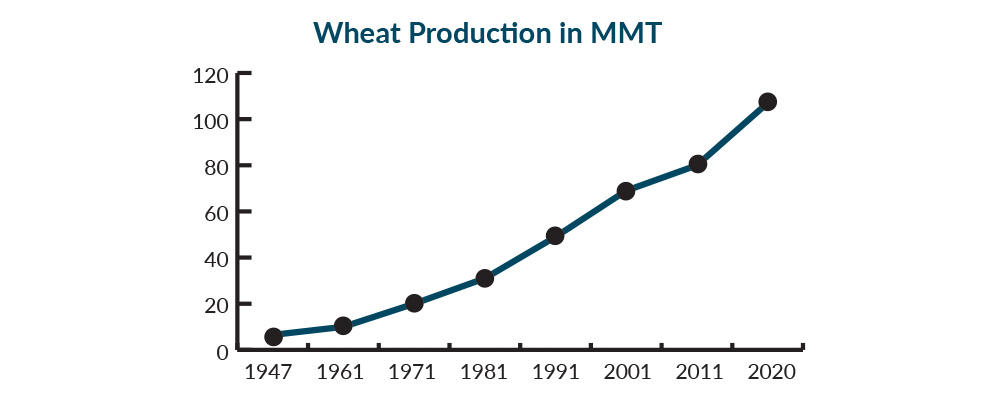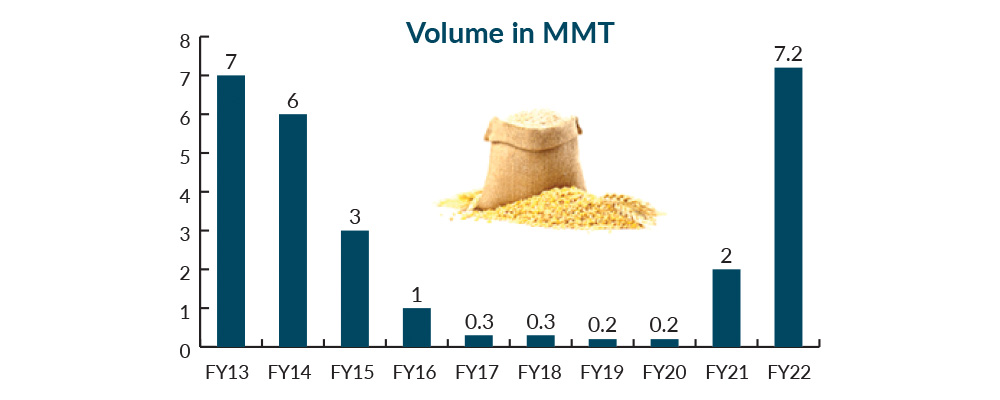Wheat is one of the most important and largest cultivated cereal crops in the world and counts as a staple food grain for most countries. It is also one of the most traded agri- commodities.
In India, it holds a revered position in agriculture. Its annual yield was almost 107.59 MMT (in a 31.45Mn Ha area) during the 2019-20 July-June period, which is higher by 11.43 MMT than the average wheat production of 96.16 MMT in the country.
India is also one of the largest producers of wheat globally – the 2nd largest after China, and accounts for approximately 14 percent share of total global wheat production.
- Production – geographical layout
Wheat cultivation in India has traditionally been dominated by the northern region of India. The largest wheat producing states are Uttar Pradesh, Madhya Pradesh, Punjab, Haryana, Rajasthan, Bihar and Gujarat.
The below table provides the top 10 states that contribute towards production of wheat in India:
| SN. | State | Production (MMT) | Share (%) |
|---|---|---|---|
| 1 | Uttar Pradesh | 33.82 | 31% |
| 2 | Madhya Pradesh | 19.61 | 18% |
| 3 | Punjab | 17.62 | 16% |
| 4 | Haryana | 11.88 | 11% |
| 5 | Rajasthan | 10.92 | 10% |
| 6 | Bihar | 5.58 | 5% |
| 7 | Gujarat | 3.33 | 3% |
| 8 | Maharashtra | 1.79 | 2% |
| 9 | Uttarakhand | 0.90 | 1% |
| 10 | Himachal Pradesh | 0.56 | 1% |
| 11 | Others | 1.86 | 2% |
| G. Total | 107.86 |
Source: APEDA
Wheat is a rabi crop and is mainly harvested from March onwards.
However, due to its susceptibility to unexpected changes of weather, the wheat crop in India faces a unique problem of cyclical periods which consists of huge surplus crop followed by drastic falls in production, and thus, India assumes the role of a net exporter alternated by net importer.

- Evolution of wheat in India
Wheat is India’s biggest winter crop, with planting happening in October and November, and harvesting in March and April. The production and productivity of wheat was quite low when India became independent in 1947. During 1950-61, the production of wheat was only 6.5 MMT and productivity was merely 663 kg per hectare, which was not sufficient to meet domestic demand, compared to 3,421 kg per hectare in 2019-20. To help bridge this gap, the country used to import wheat in large quantities from many countries like USA.
The reasons of low wheat production and productivity earlier were:
- The tall growing plant habit resulting in lodging, when grown under fertile soils
- The poor tillering and low sink capacity of the varieties used
- Higher susceptibility to diseases
- Higher sensitivity to thermo and photo variations etc., resulting in poor adaptability
- Longer crop duration resulting in a long exposure of plants to the climatic variations and insect pest / disease attacks
- Famines in India
After 1947, independent India was left with 82 percent of the population and only 75 percent of the cereal production, causing significant food insecurity.
In the year of independence, the government formed a food policy commission to advise measures to increase domestic food production and procurement. However, despite several recommendations from the commission, foodgrain production plateaued in the 1950’s.
The following decades saw the magic of the Green Revolution that spurred agricultural output with high-yielding variety seeds and a more scientific approach.
The Government of India appointed a commission in 1961 to assess the feasibility of increasing crop productivity under prevailing Indian ecological conditions. Also, Food Corporation of India (FCI), was set up in 1965 to regulate a system that could resolve the food problems of the country and to meet contingencies in the future, especially considering the aftermath of the famine in Bengal in 1943. FCI stabilised agricultural prices with market intervention and price support. As result of various steps taken by Govt. of India, the wheat scenario in India has completely changed.
Below graph shows the growth of wheat production in the country:
Source: Bloomberg

After averting a famine in 1965, India began agricultural reforms that put it on a pathway for increased production. Immediately post-independence, the country used to import wheat for consumption. However, due to bumper increase in the production and productivity of wheat during the Green Revolution period in the late sixties, the country became self-sufficient in wheat production.
In view of surplus production and higher availability in the domestic market, import tariff on wheat had been increased from the prevailing 30 percent to 40 percent in April 2019, to discourage imports and safeguard the domestic farming community.
India has already built a formidable reputation as an exporter of quality wheat, comparable to the US Soft Red Winter (SRW) variety and the Black Sea milling varieties, at value prices. Indian wheat that is exported, normally, has moisture not exceeding 12 percent, a minimum protein of 11.5 percent, gluten at minimum 26 percent, and a falling number of 400 seconds minimum, which makes it a strong competitor to wheat from other origins.
- Production, consumption and EXIM
Below table provides the statistics on the Indian wheat scenario:
| SN. | Particulars | 2020-21* (MMT) | 2021-22* (MMT) |
|---|---|---|---|
| 1 | Carry over stock | 26.92 | 31.21 |
| 2 | Production | 103.21 | 102.68 |
| 3 | Imports | - | - |
| 4 | Total availability (1+2+3) | 130.13 | 133.81 |
| 5 | Consumption | 96.99 | 97.30 |
| 6 | Exports | 1.93 | 3.27 |
| 7 | Total usage (5+6) | 98.92 | 100.57 |
| 8 | Closing Stock (4-7) | 31.21 | 33.32 |
Source: Agriwatch
*July-June
India’s wheat exports was under 0.3 MMT during FY16 to FY20. However, in subsequent years exports increased from 2 MMT in FY21 to 7.2 MMT in FY22, owing to surplus production coupled with higher carryover stock.
The below graph shows the exports of wheat from India over past 10 years:

Wheat exports in MMT
Source: APEDA
Kandla (3.4 MMT-FY22) and Mundra (0.4 mmt-FY22) ports in the western state of Gujarat are the main gateways for wheat exports from India.
- India's Journey from a famine-ridden country to becoming a food exporter
From an importer to an exporter, India has turned the tides and extensive research efforts are underway for improving the crop output even during adverse weather conditions in the years to come.
Due to favorable logistical advantages, India is now a preferred source for exports to such destinations as Bangladesh, Middle East Asian countries, South-East Asian countries, and African countries such as Ethiopia. However, even though India breaks its wheat export numbers every year, tackling domestic hunger is still a challenge in the country. Experts suggest that a more robust public distribution system and a more efficient supply chain, might be the key aspects to ponder while addressing the issue.